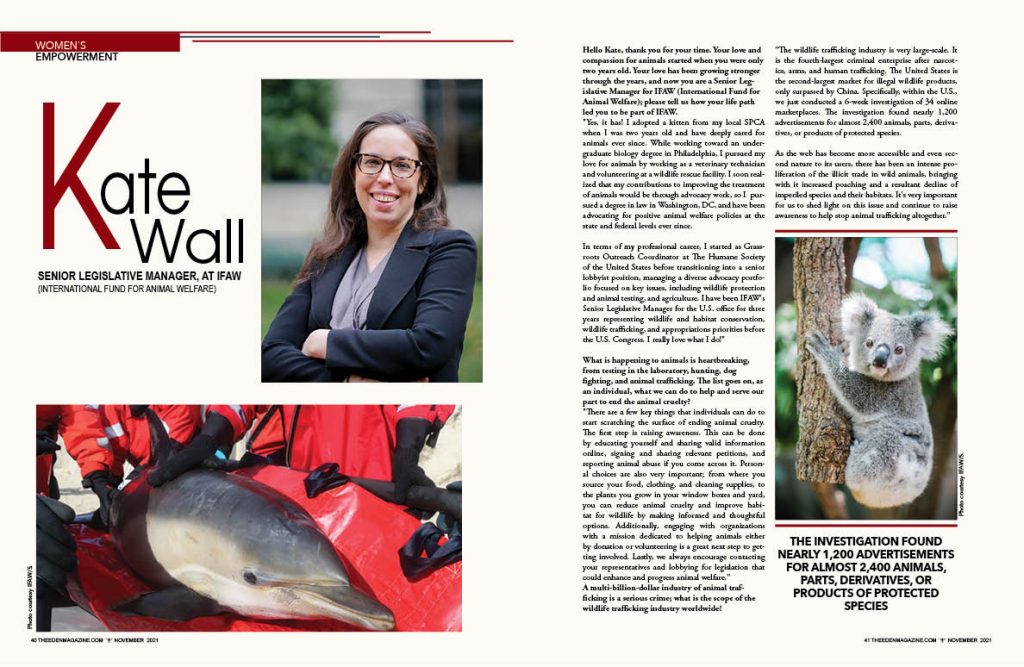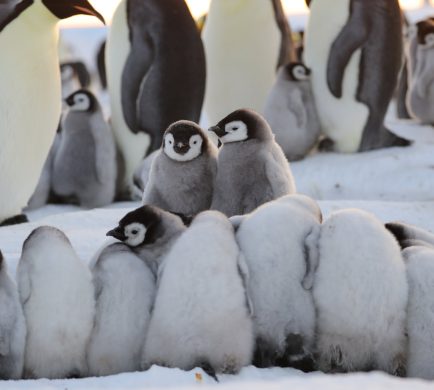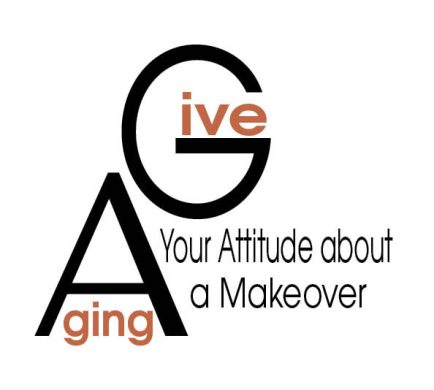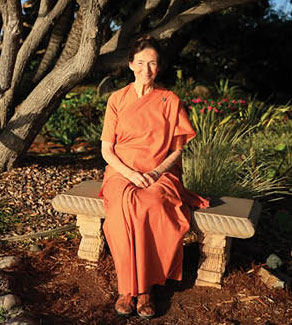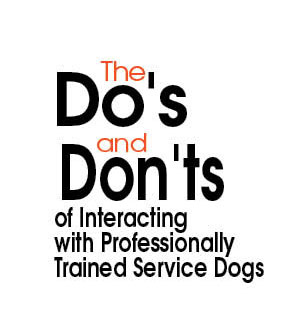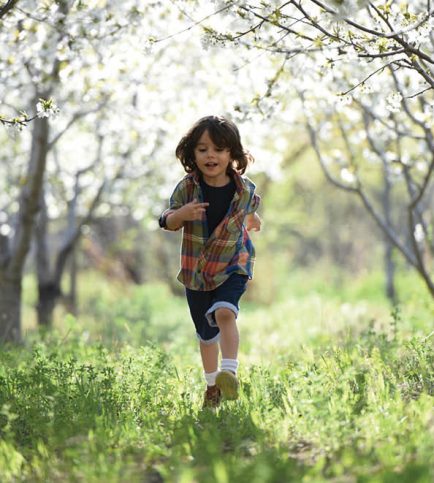By Amanda Hainline
Hello Kate, thank you for your time. Your love and compassion for animals started when you were only two years old. Your love has been growing stronger through the years, and now you are a Senior Legislative Manager for IFAW (International Fund for Animal Welfare); please tell us how your life path led you to be part of IFAW.
“Yes, it has! I adopted a kitten from my local SPCA when I was two years old and have deeply cared for animals ever since. While working toward an undergraduate biology degree in Philadelphia, I pursued my love for animals by working as a veterinary technician and volunteering at a wildlife rescue facility. I soon realized that my contributions to improving the treatment of animals would be through advocacy work, so I pursued a degree in law in Washington, DC, and have been advocating for positive animal welfare policies at the state and federal levels ever since.
In terms of my professional career, I started as Grassroots Outreach Coordinator at The Humane Society of the United States before transitioning into a senior lobbyist position, managing a diverse advocacy portfolio focused on key issues, including wildlife protection and animal testing, and agriculture. I have been IFAW’s Senior Legislative Manager for the U.S. office for three years representing wildlife and habitat conservation, wildlife trafficking, and appropriations priorities before the U.S. Congress. I really love what I do!”
What is happening to animals is heartbreaking, from testing in the laboratory, hunting, dog fighting, and animal trafficking. The list goes on, as an individual, what we can do to help and serve our part to end the animal cruelty?
“There are a few key things that individuals can do to start scratching the surface of ending animal cruelty. The first step is raising awareness. This can be done by educating yourself and sharing valid information online, signing and sharing relevant petitions, and reporting animal abuse if you come across it. Personal choices are also very important; from where you source your food, clothing, and cleaning supplies, to the plants you grow in your window boxes and yard, you can reduce animal cruelty and improve habitat for wildlife by making informed and thoughtful options. Additionally, engaging with organizations with a mission dedicated to helping animals either by donation or volunteering is a great next step to getting involved. Lastly, we always encourage contacting your representatives and lobbying for legislation that could enhance and progress animal welfare.”
A multi-billion-dollar industry of animal trafficking is a serious crime; what is the scope of the wildlife trafficking industry worldwide?“
As the web has become more accessible and even second nature to its users, there has been an intense proliferation of the illicit trade in wild animals, bringing with it increased poaching and a resultant decline of imperiled species and their habitats. It’s very important for us to shed light on this issue and continue to raise awareness to help stop animal trafficking altogether.”
What are some actions people can take to curb the growth of illegal wildlife trafficking?
“There are many actions needed to curb the growth of illegal wildlife trafficking. We really need to focus on reducing the demand for live wild animals and wild animal parts, as many who fuel the demand likely do so unknowingly—as consumers, not buying wildlife products can greatly reduce the market demand that fuels trafficking. Individuals can also commit to learning more and engaging with decision-makers and organizations to produce effective policies and laws that protect individual wild animals, wild populations, and their habitats. If they see suspicious activity, they can also report it to national law enforcement authorities.”
Between building more houses, roads, and commercial buildings, How can we stop disrupting wildlife habitats?
“With industrial expansion never ceasing, wildlife corridors are a way for wild animals to get from one place to another. It’s not enough to just have protected areas, because, like us, wildlife needs to be able to move around to access food, water, and others of their species. Corridors are pathways that connect protected areas so that we don’t simply wind up with isolated islands of protected areas cut off from one another by development. They allow animals to move from one protected area to another in order to promote genetic diversity, pursue normal migration patterns, and respond to changing conditions – especially important during the era of climate change. Importantly, wildlife corridors can coexist with many kinds of human development; through a mixture of structures like overpasses and underpasses, native planting, creative fencing, and other measures. Corridors can help safely guide wildlife around and through developed lands.
“What are “Wet Markets,” and why are they considered a prime suspect in many disease outbreaks?“
Wet markets,” technically, are markets that sell fresh meat and produce outside a supermarket setting, much like the farmers’ markets we’re all familiar with. During this COVID-19 pandemic, the term “wet market” has been confused with live wildlife markets, where live wild animals are held, slaughtered, and sold. These live wildlife markets keep captive animals very close together in high-stress situations where they contact one another’s saliva or feces. Live wildlife markets are veritable Petri dishes for the development of novel diseases, and the diseases can easily jump to humans through contact with infected animals, especially during slaughter and consumption.”
The IFAW mission is to help animals and people thrive together, and their focus is not only for the wildlife, instead, Animals, People, and Planet; please tell us more about it.
“Everything is interconnected: animals, humans, and the planet we all share at IFAW. Our focus is on rescuing, rehabilitating, and releasing animals; we restore and protect their natural habitats and work to ensure policies supporting animals and the planet. The problems we’re up against are urgent and complicated. To solve them, we match fresh thinking with bold action. We partner with local communities, governments, non-governmental organizations, and businesses. Together, we pioneer new and innovative ways to help all species flourish. We are creating better outcomes for animals, for people, and for the places we call home.
When we rescue one animal—a house pet abandoned in a hurricane, a cow displaced by an earthquake, a right whale entangled in a fishing line—we’re doing much more than saving a life. We’re reuniting a family. We’re restoring a community’s livelihood. We’re saving a species on the brink of extinction. We’re saving our planet.
“California is facing a horrible wildlife fire, many, and this is disastrous for wildlife; how can we do our part as an individual to avoid it in the future? “
Fires have been ravaging California for months. Long periods of severe drought, very dry fuels, dry soils, and excessive heat have contributed to these fires. Record-breaking temperatures, including days where weather conditions are considered “catastrophic,” have also impacted wildlife, with animals suffering dehydration and birds and flying foxes (bats) falling dead from the sky. All of these factors have been compounded by climate change. If you’re not in a position to donate to an organization on the ground in California (or other areas that are experiencing extreme weather), you can still help. Actions you can take include:
-Consume less, recycle and re-use
-Invest in renewable energy
-Consider how you travel on holidays (go local or take the train instead of flying)
-Walk or bike instead of using a car, when possible
Lobby for more green space in your own neighborhood and plant more native plants in your own garden (if you have one)
-Purchase local food from farmers and eat with the seasons Make your voice heard and vote for legislation that supports environmental protection
Every year in the U.S., an estimated 1 to 2 million collisions occur between motorists and large animals, resulting in 200 human deaths and 26,000 injuries – costing the U.S. 8 billion dollars annually; what are the safety precautions that have been offered?
“The INVEST Act that was passed out of the U.S. House of Representatives includes 400 million dollars for wildlife crossings—structural elements like underpasses, overpasses, culverts, crosswalks, or animal detection systems, allowing wildlife to avoid road traffic. That makes everyone safer. And they are wildly effective; studies demonstrate that wildlife crossing structures like these reduce wildlife-vehicle collisions by up to a staggering 97%. Adding wildlife crossings can effectively save human and animal lives, produce cost savings for the nation to the tune of billions of dollars annually, and support more resilient landscapes by allowing wildlife to move more freely, particularly in the face of climate change.”
What is your day to relax?
Passing conservation laws and policies in the United States takes a very long time – usually years of hard work and often lots of talking, writing, and intense negotiation. I think that’s why when I step away from the computer, my favorite activities are physically tiring and have very tangible results. I love native plant gardening and never get tired of adding new plants to our little backyard habitat. I also enjoy woodworking and DIY projects around the house, as well as hiking and canoeing. Sometimes, though, I like to just curl up on the sofa with my husband and our cats and watch TV!
What would you like to share with our readers if they want to be a part of IFAW to help?
“There are many different initiatives IFAW is always working on, and there are multiple ways you can get involved. With so many threats against animal welfare worldwide, IFAW needs all the help it can get. One of the easiest ways to help IFAW is to give a charitable donation on our donation website. If you are unable to make a donation, there are various other ways you can give back. IFAW offers volunteer opportunities to help aid in their various programs. Volunteer work can be anything from collecting donations to working out in the field. If you are looking for a way to volunteer your time, sign up for our action alerts. These alerts will help you stay up to date on current animal issues and educate you on what you can do to help animals around the world.”

